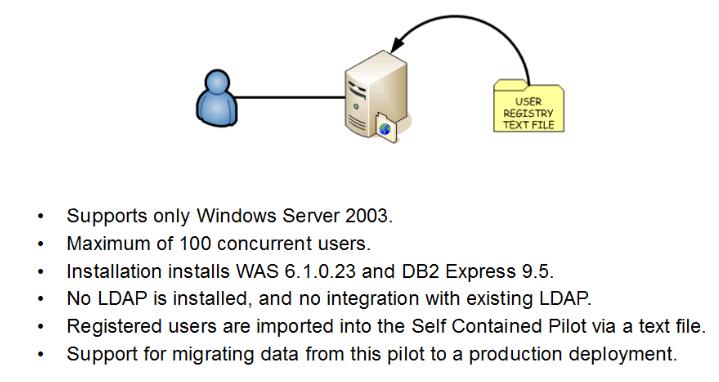Install a pilot deployment
Install a pilot deployment of Lotus Connections to evaluate its features and benefits.

If you can, skip installing the pilot.
A pilot deployment minimizes administration effort by simplifying configuration. The pilot includes all the ancillary software that you need to run Lotus Connections, including IBM WebSphere Application Server and IBM DB2 Express Edition.
The pilot is installed on a single WebSphere Application Server profile, and does not support clustering or fail over.
If you decide to move from the pilot to a production deployment, you can migrate data from the pilot.
What's included in the pilot deployment
The pilot includes the following software:- WebSphere Application Server version 6.1.0.23 and all required fix packs
- DB2 Express Edition version 9.5 Fix Pack 3
- One or more Lotus Connections features: Activities, Blogs, Communities, Dogear, Files, Home page, Mobile, News, Profiles, Search, or Wikis
- IBM Tivoli Directory Integrator 6.1.1 Fix Pack 6
- Preconfigured DB2 databases for each installed feature
- A prepopulated Profiles database with user data
Hardware and software requirements
The hardware requirements of a pilot installation are like those of a single-server production installation, except that you need only one system on which to install the product. For more information, see the Hardware and software requirements topic.
The pilot version is available for Microsoft Windows Server 2003 Standard and Enterprise Edition, SP2. No other operating systems are supported.
Limitations on adding features to an existing pilot deployment
If you install some features now and later decide to use the remaining features, you cannot add them to an existing pilot deployment. Instead, remove the existing pilot deployment and reinstall it. This limitation means that you lose any user data that you created in the pilot deployment. To avoid losing data, install all the features when you install the pilot for the first time. During the installation procedure, you can choose to deploy only those features that you want to evaluate. You can deploy the remaining features at any time.
- Create a user information file
Use actual user identities with the pilot deployment of Lotus Connections. - Install the pilot deployment
Install the pilot deployment of Lotus Connections to evaluate the product in a stand-alone deployment. This type of installation is suitable for product evaluation purposes only and is not intended for use in a production environment. - Accessing the pilot deployment
Log into and evaluate the pilot deployment of Lotus Connections. - Change the pilot configuration
Configure security and user accounts in the pilot deployment of Lotus Connections. - Designating an administrative user for a pilot deployment
The installation wizard creates a default administrative user for each feature called connectionsAdmin and assigns the search-admin role to that user. If necessary, grant administrative access to more users for a Lotus Connections feature. - Add actual users to the pilot
Add actual users to the pilot installation if you plan to migrate to a production installation of Lotus Connections. - Uninstall a pilot deployment
Uninstall a pilot deployment of IBM Lotus Connections.
Migrating a pilot to a production deployment
Related reference
Lotus Connections detailed system requirements